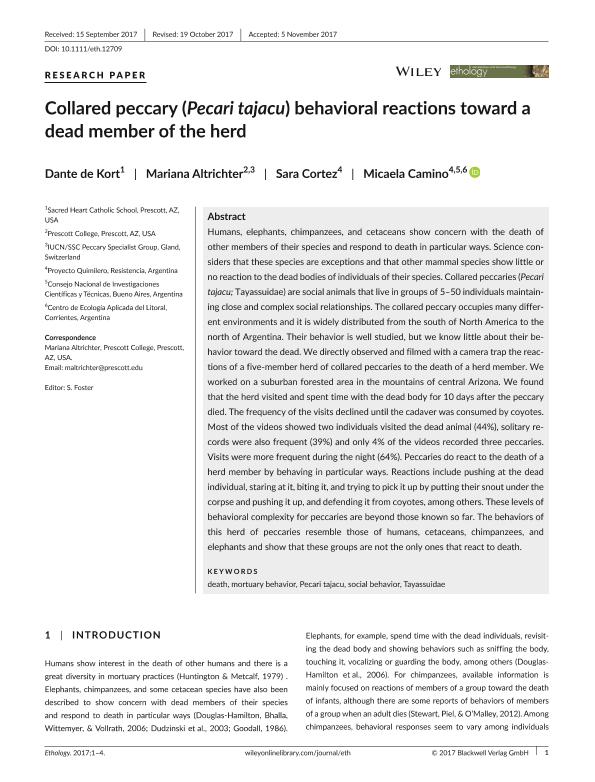Mostrar el registro sencillo del ítem
dc.contributor.author
de Kort, Dante
dc.contributor.author
Altrichter, Mariana

dc.contributor.author
Cortez, Sara
dc.contributor.author
Camino, Micaela

dc.date.available
2019-09-17T21:20:38Z
dc.date.issued
2018-02
dc.identifier.citation
de Kort, Dante; Altrichter, Mariana; Cortez, Sara; Camino, Micaela; Collared peccary (Pecari tajacu) behavioral reactions toward a dead member of the herd; Wiley Blackwell Publishing, Inc; Ethology; 124; 2; 2-2018; 131-134
dc.identifier.issn
0179-1613
dc.identifier.uri
http://hdl.handle.net/11336/83770
dc.description.abstract
Humans, elephants, chimpanzees, and cetaceans show concern with the death of other members of their species and respond to death in particular ways. Science considers that these species are exceptions and that other mammal species show little or no reaction to the dead bodies of individuals of their species. Collared peccaries (Pecari tajacu; Tayassuidae) are social animals that live in groups of 5–50 individuals maintaining close and complex social relationships. The collared peccary occupies many different environments and it is widely distributed from the south of North America to the north of Argentina. Their behavior is well studied, but we know little about their behavior toward the dead. We directly observed and filmed with a camera trap the reactions of a five-member herd of collared peccaries to the death of a herd member. We worked on a suburban forested area in the mountains of central Arizona. We found that the herd visited and spent time with the dead body for 10 days after the peccary died. The frequency of the visits declined until the cadaver was consumed by coyotes. Most of the videos showed two individuals visited the dead animal (44%), solitary records were also frequent (39%) and only 4% of the videos recorded three peccaries. Visits were more frequent during the night (64%). Peccaries do react to the death of a herd member by behaving in particular ways. Reactions include pushing at the dead individual, staring at it, biting it, and trying to pick it up by putting their snout under the corpse and pushing it up, and defending it from coyotes, among others. These levels of behavioral complexity for peccaries are beyond those known so far. The behaviors of this herd of peccaries resemble those of humans, cetaceans, chimpanzees, and elephants and show that these groups are not the only ones that react to death.
dc.format
application/pdf
dc.language.iso
eng
dc.publisher
Wiley Blackwell Publishing, Inc

dc.rights
info:eu-repo/semantics/openAccess
dc.rights.uri
https://creativecommons.org/licenses/by-nc-sa/2.5/ar/
dc.subject
Death
dc.subject
Mortuary Behavior
dc.subject
Pecari Tajacu
dc.subject
Social Behavior
dc.subject
Tayassuidae
dc.subject.classification
Ecología

dc.subject.classification
Ciencias Biológicas

dc.subject.classification
CIENCIAS NATURALES Y EXACTAS

dc.title
Collared peccary (Pecari tajacu) behavioral reactions toward a dead member of the herd
dc.type
info:eu-repo/semantics/article
dc.type
info:ar-repo/semantics/artículo
dc.type
info:eu-repo/semantics/publishedVersion
dc.date.updated
2019-08-01T20:11:29Z
dc.identifier.eissn
1439-0310
dc.journal.volume
124
dc.journal.number
2
dc.journal.pagination
131-134
dc.journal.pais
Reino Unido

dc.journal.ciudad
Londres
dc.description.fil
Fil: de Kort, Dante. Sacred Heart Catholic School, Prescott; Estados Unidos
dc.description.fil
Fil: Altrichter, Mariana. Prescott College; Estados Unidos. International Union For Conservation Of Nature And Natural Resources; Suiza
dc.description.fil
Fil: Cortez, Sara. Proyecto Quimilero; Argentina
dc.description.fil
Fil: Camino, Micaela. Consejo Nacional de Investigaciones Científicas y Técnicas. Centro Científico Tecnológico Conicet - Nordeste. Centro de Ecología Aplicada del Litoral. Universidad Nacional del Nordeste. Centro de Ecología Aplicada del Litoral; Argentina. Proyecto Quimilero; Argentina
dc.journal.title
Ethology

dc.relation.alternativeid
info:eu-repo/semantics/altIdentifier/doi/http://dx.doi.org/10.1111/eth.12709
dc.relation.alternativeid
info:eu-repo/semantics/altIdentifier/url/https://onlinelibrary.wiley.com/doi/abs/10.1111/eth.12709
Archivos asociados
